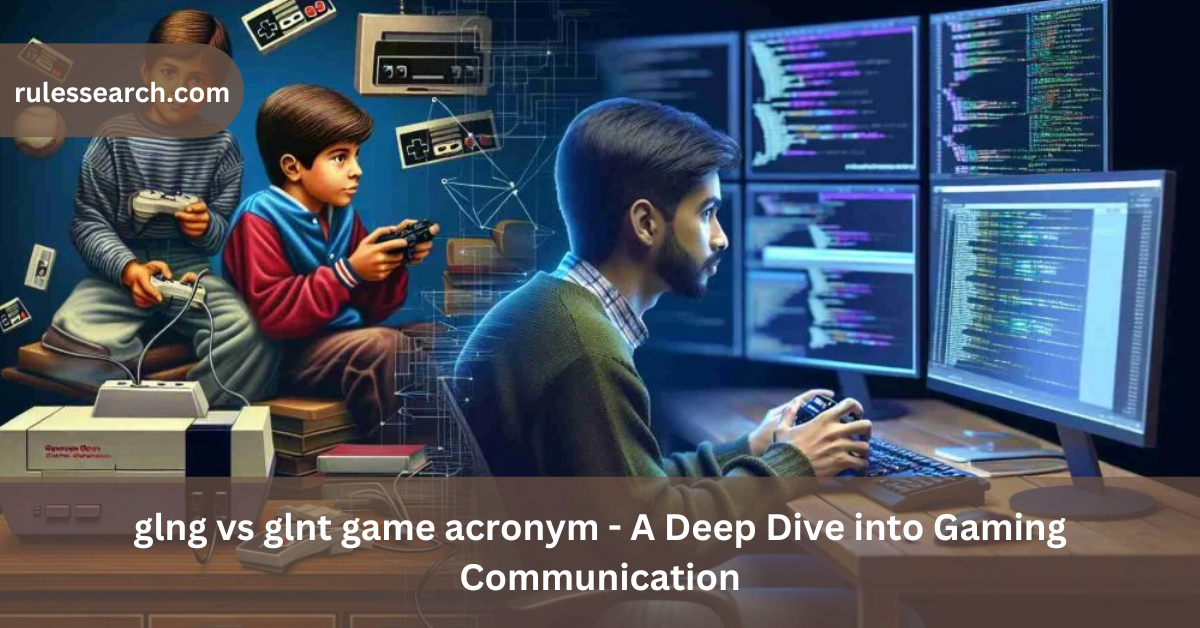In the ever-evolving world of online gaming, communication is key. Whether you’re coordinating with your team in a heated multiplayer match or sharing strategies in a sprawling MMO, the way players communicate can greatly impact their gaming experience. One aspect of this communication is the use of acronyms—shorthand expressions that convey a lot of meaning in just a few letters. Among the vast lexicon of gaming acronyms, two that have recently gained traction are glng vs glnt game acronym. These acronyms have sparked curiosity, debate, and even confusion among gamers, especially in the USA.
In this comprehensive guide, we’ll explore what these acronyms mean, how they’re used, and why they’ve become so popular. We’ll also delve into the broader context of gaming acronyms, analyzing their role in enhancing gameplay, fostering community, and sometimes causing misunderstandings.
Understanding Gaming glng vs glnt game acronym
Before diving into the specifics of glng vs glnt game acronym, it’s important to understand the role of acronyms in the gaming world. Gaming acronyms are often used to convey complex ideas quickly, allowing players to communicate efficiently in the heat of the moment. This shorthand language has evolved as a necessity in fast-paced gaming environments where every second counts.
Why Acronyms Matter in Gaming
- Speed and Efficiency: In a high-stakes game, typing out full sentences can be time-consuming and detrimental to performance. Acronyms allow players to relay important information quickly.
- Universal Language: Acronyms often transcend language barriers, enabling players from different countries and linguistic backgrounds to understand each other. This creates a more inclusive gaming environment.
- Community Building: Shared acronyms and shorthand expressions help foster a sense of belonging within the gaming community. When players use the same lingo, they feel like part of a larger, connected group.
The Rise of glng vs glnt game acronym
GLNG and GLNT are two acronyms that have recently gained popularity in gaming circles. Their usage has spread across various gaming platforms, but their meanings have left some players scratching their heads. Let’s break down each acronym and explore its significance.
What Does GLNG Mean?
GLNG stands for Good Luck, No Griefing. This acronym is often used at the beginning of a match or game session to wish others good luck while also emphasizing the importance of fair play. No griefing refers to avoiding disruptive behavior that negatively affects the game for others, such as trolling, cheating, or intentionally sabotaging teammates.
The Importance of Fair Play
In competitive gaming, fairness is paramount. Griefing can ruin the experience for other players and undermine the integrity of the game. By including No Griefing in the acronym, players are not just wishing each other luck—they’re also promoting a positive and respectful gaming environment.
How GLNG Fosters a Positive Community
Using GLNG at the start of a game sets a tone of sportsmanship and mutual respect. It signals to other players that you’re committed to playing the game fairly and expect the same in return. This can help reduce toxic behavior and create a more enjoyable experience for everyone involved.
What Does GLNT Mean?
GLNT stands for Good Luck, No Teaming. This acronym is particularly relevant in battle royale games and other competitive formats where teaming—two or more players working together in a free-for-all environment—is against the rules.
Why Teaming is Controversial
Teaming can give players an unfair advantage in games where the expectation is that every player or team fights for themselves. It’s considered a form of cheating because it undermines the competitive balance of the game. By stating No Teaming upfront, players are reaffirming their commitment to playing by the rules.
The Role of GLNT in Competitive Integrity
GLNT is often used in solo modes of popular games like Fortnite or PUBG, where players want to ensure that the game remains a true test of individual skill. When everyone plays by the same rules, the competition is more intense, and victories feel more earned.
The Broader Impact of Acronyms like glng vs glnt game acronym
The rise of glng vs glnt game acronym highlights how acronyms can do more than just save time—they can also influence the culture and dynamics of online gaming communities.
Promoting Ethical Gaming
Both glng vs glnt game acronym carry ethical undertones, encouraging players to uphold the rules and treat others with respect. This reflects a growing awareness within the gaming community about the importance of ethics and sportsmanship.
The Role of Game Developers
Game developers have started to take notice of the importance of promoting fair play. Some games now include automated systems to detect and penalize griefing or teaming, reinforcing the principles behind acronyms like glng vs glnt game acronym.
The Spread of Gaming Lingo
As gaming becomes more global, acronyms like glng vs glnt game acronym are spreading across different regions and platforms. This helps create a shared language that unites players from diverse backgrounds, fostering a more cohesive global gaming community.
From Niche to Mainstream
What starts as a niche term among a specific group of players can quickly become mainstream as more people adopt the acronym. The widespread use of GLNG and GLNT is a testament to how quickly gaming culture evolves and how acronyms play a key role in that evolution.
The Future of Gaming Acronyms
As online gaming continues to grow, so too will the lexicon of acronyms. New games, genres, and player behaviors will inevitably lead to the creation of new terms. However, the success and longevity of these acronyms will depend on how well they resonate with players and reflect the values of the gaming community.
The Evolution of Language in Gaming
Language in gaming is dynamic and ever-changing. Acronyms like GLNG and GLNT are just the latest examples of how players create and adapt language to fit their needs. As gaming technology and platforms evolve, so too will the ways in which players communicate.
Integrating New Technologies
With the rise of voice recognition and AI-powered communication tools, the use of acronyms might shift or evolve. However, the underlying need for quick, efficient communication in gaming is unlikely to change, ensuring that acronyms will remain a staple of gaming culture.
The Role of Community Feedback
Community feedback plays a crucial role in the adoption and evolution of gaming acronyms. If a term resonates with players, it will spread quickly and become part of the gaming lexicon. Conversely, if it doesn’t catch on, it may fade into obscurity.
Conclusion
In the world of online gaming, acronyms like glng vs glnt game acronym are more than just shorthand—they’re expressions of the values and culture of the gaming community. These acronyms reflect a commitment to fair play, ethical behavior, and respect for fellow players. As gaming continues to evolve, so too will the language players use, but the core principles behind these acronyms are likely to remain relevant for years to come.
By understanding and embracing these acronyms, players can enhance their gaming experience and contribute to a more positive, respectful, and inclusive gaming environment.
FAQs
1. What does GLNG stand for in gaming?
GLNG stands for Good Luck, No Griefing. It’s a way for players to wish each other good luck while also promoting fair play by discouraging disruptive behavior known as griefing.
2. What does GLNT mean in the context of online games?
GLNT stands for Good Luck, No Teaming. It’s commonly used in competitive games where teaming up in solo modes is against the rules, ensuring that the competition remains fair.
3. Why are acronyms like glng vs glnt game acronym important in gaming?
These acronyms are important because they promote ethical behavior and fair play in online games, helping to create a positive gaming environment.
4. How do acronyms enhance communication in games?
Acronyms allow players to communicate quickly and efficiently, which is crucial in fast-paced gaming environments where time is of the essence.
5. What is griefing, and why is it discouraged?
Griefing is disruptive behavior that negatively impacts other players’ gaming experiences. It’s discouraged because it undermines the fairness and enjoyment of the game.
6. What is teaming in gaming, and why is it controversial?
Teaming occurs when players cooperate in a free-for-all game mode where everyone is supposed to compete individually. It’s controversial because it gives an unfair advantage and disrupts the balance of the game.
7. How can using glng vs glnt game acronym improve my gaming experience?
By using these acronyms, you can set a tone of sportsmanship and respect, which can lead to a more enjoyable and fair gaming experience for everyone involved.
8. Are there other similar acronyms used in gaming?
Yes, there are many acronyms in gaming that promote fair play and communication, such as GG (Good Game) and GLHF (Good Luck, Have Fun).
9. How do gaming acronyms spread across different communities?
Gaming acronyms often spread through social media, streaming platforms, and in-game chats, becoming popular as more players adopt them.
10. Will acronyms like glng vs glnt game acronym remain relevant in the future?
As long as the principles of fair play and ethical behavior remain important in gaming, acronyms like glng vs glnt game acronym are likely to stay relevant. However, they may evolve or be joined by new terms as gaming culture continues to develop.



